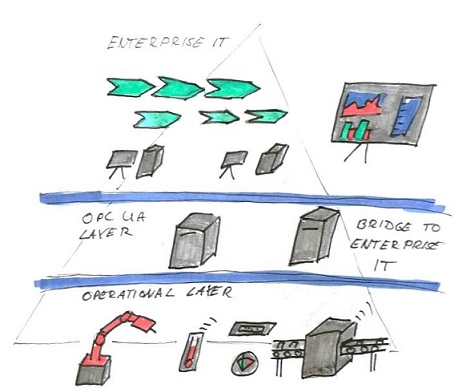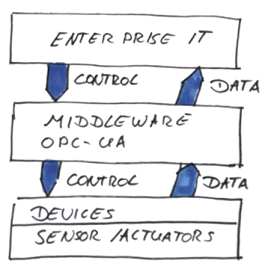OPC UA - Bridging Manufacturing and Enterprise IT
(republished on Cattle Crew Blog) Between the automation/manufacturing area and the enterprise information technology has been a disruption that is historically driven. Automation is closer to hardware so that the software evolved differently than software used on enterprise level. Moreover, it is easier to replace a business application than machines and controller in production lines. This is why different principles have been applied to both domains.
Nevertheless, disciplines in computing are getting closer which is driven by the digitalization as well as fastening innovation cycles. As a result, the wish to have production data and, therefore, insights into production processes is mentioned often. Moreover, Internet of Things even promises to influence processes from a business perspective. From the perspective of the automation area it means, that integration with the enterprise sector is required.
One huge challenge you come across is the underlying software stack when integrating enterprise and manufacturing solutions. Former manufacturing technologies like OPC (Open Platform Communication, newly called OPC Classic) are based on windows COM/DCOM interfaces to control actuators and consume messages from sensors. This differs completely compared to the approach used in enterprise applications. Today, communication between systems and applications is mainly based on web technology while in manufacturing other industry protocols are used.
To overcome this disruption and to enable communication between manufacturing and enterprise, OPC UA (Open Platform Communication – Open Architecture) was designed, which brings us one huge step closer to Industry 4.0 ideas. Basically, OPC UA is a kind of middleware and, therefore, a bridge to the enterprise IT.

There are several controller systems on the market which are able to connect to an OPC UA Server. These controllers have typically sensors and actuators attached which can be controlled by OPC UA. Moreover, OPC UA provides a SOAP based API that can be called by any kind of client. Processes, dashboards and other kinds of applications can therefore request data from sensors and can interact with actuators. With the help of an enterprise service bus this API can even made be available as an enterprise wide business service.
With such a setup it is possible to leverage data from manufacturing and production to enhance enterprise applications. BPM applications, Big Data principles and analysis, modern clients, dashboards and much more topics can suddenly be combined with production data. Furthermore, these applications can be used to control processes as well as devices. Therefore, in production we gain the same control loop that can be found in IoT scenarios.

As an example: imagine, sales acquired a highly prioritized order for some technical goods that needs to be produced. As soon as the order is entered into the company’s order management platform automated processes start to reorganize the production plans and to inform machines in the production lines. Machines are updated with the new specification so that the newly ordered goods are produced. As a result, OPC UA has the chance to play a big role in Industry 4.0 and is a piece of technology one should definitely have an eye on.